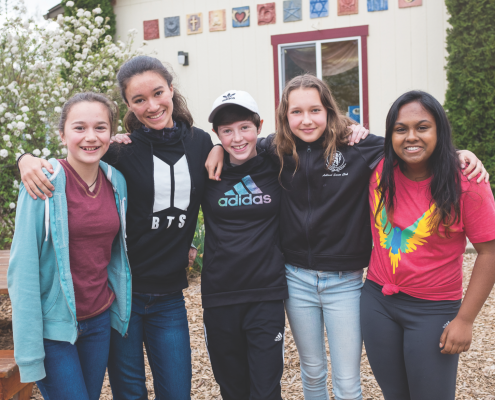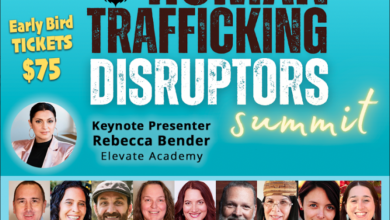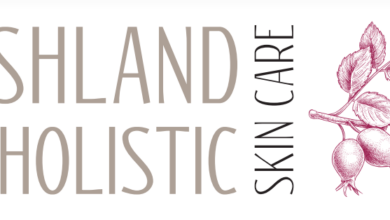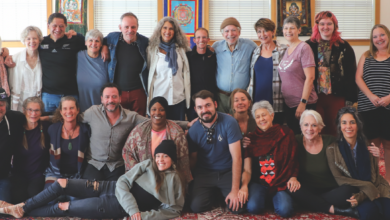The Siskiyou School Waldorf Education in Ashland
This year the Siskiyou School in Ashland, Oregon is joining Waldorf schools around the world in celebrating 100 years of Waldorf education. Waldorf education offers an innovative approach to learning that has stood the test of time. Its developmental curriculum meets children academically and emotionally at each grade level, fostering creative thinking, adaptability, self-motivation, empathy and resilience–important skills for living in the world today. There are more than 1100 Waldorf schools in over 200 countries, providing a holistic educational model inclusive of academics, the arts, music, and more. In the United States there are 150 schools.
The Siskiyou School offers enriching opportunities not only for their students, but for parents as well. Its Parent Enrichment Program offers presentations and discussion forums throughout the school year on topics related to parenting and education. The Siskiyou School is also known for its festivals. Its WinterFaire in mid-November is one of the most magical, creative and fun community events in the Valley for children and parents.
Join me in learning more while I speak with Siskiyou School Administrator, Aurilia McNamara. Originally from Germany, Aurilia herself grew up with Waldorf education. She attended and graduated from the very first Waldorf school, the Stuttgart Waldorf School, founded in 1919. Aurilia has three sons. Two of them have graduated from the Siskiyou School and are now at Ashland High School, and her youngest son is currently in the 7ththgrade.
Welcome Aurilia, and thank you very much for speaking with us today. Please give us an introduction to Waldorf education. Where and how did it begin?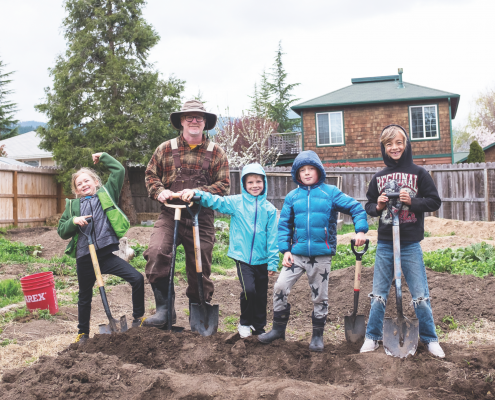
Waldorf education was founded in 1919 in Germany by Rudolf Steiner, an Austrian philosopher, scientist, and visionary. Steiner envisaged a curriculum that would meet children at each stage of their development and a methodology that would develop children’s’ intellectual, artistic, practical, and social/emotional skills in an integrated and holistic manner. His goal was to create an educational system that would educate free, morally responsible, grounded, and well-integrated human beings, people who would be capable of rebuilding the world in a new way after the devastation wrought by WWI. His ideas were first tried out in a school he created for the children of factory workers. That factory was known as the Waldorf factory. His experiment was so successful other schools adopted his model. For the last one hundred years, all schools inspired by his ideas have been called Waldorf schools.
I have often heard Waldorf referred to as the education of the “head, heart, hands”. What does that refer to?
Waldorf seeks to educate the whole child, to develop and nurture not just minds of their students and their capacity to think and to imagine, (head) but also the capacity to feel, to empathize, to connect (heart) and the capacity to do, to create, to make things, to apply oneself, to put oneself into our work (hands/will). Our teachers structure lessons to engage all three of these capacities in their students, striving to develop them in a balanced way.
What does that look like in the classroom?
Vivid storytelling is an integral element of the teaching. Lessons are brought through imaginative pictures and stories that elicit feelings, that engage the heart. Students bring these lessons into themselves–integrate them–by writing and drawing, and possibly by acting or sculpting or through movement. The students’ thinking is activated when lessons are reviewed and the material is looked at and discussed from different angles. Modern brain research supports the wisdom of this multi-pronged approach. Children learn in different ways! What’s remarkable is that this methodology has been integral to Waldorf education for one hundred years!
But does the Waldorf curriculum cover all the traditional core academic subjects?
Absolutely. As Waldorf parents, you can be assured your children will get all the basics. Not only will they read and write beautifully – we teach cursive and calligraphy — but they will have been introduced to the major chapters of history from pre-Mesopotamia to modern day, the geography of the whole world, math through Algebra I and many of the sciences, including botany, geology, astronomy, physics (light, heat, sound), simple mechanics, electricity and magnetism, organic and inorganic chemistry, meteorology, and physiology.
While other schools may cover these same basic subjects by eighth grade, the difference in Waldorf schools is in HOW these subjects are brought. There’s that head/heart/hands approach I was describing before and there’s also our block system. These big subjects are taught in 3-4 week blocks during Main Lesson, a two-hour period first thing each morning–the heart of the academic day. It’s an immersion kind of learning that fosters excellent retention; children remember what they learn because in each block they are fully in it! Waldorf kids can always immediately tell you what they are studying!
What’s the “arts” part of your program?
The arts are integrated into the teaching of core academics in the way I described. Additionally, by the time they graduate, every Siskiyou School student has acquired a range of other kinds of skills and experiences. They have acted in a class play every year, they know how to knit, sew and make clothes, they can sculpt wood and make furniture, they read music and play instruments, they speak and understand some Spanish and Chinese, they are physically quite agile and able, skilled at various sports, and their art work is often dazzling! Art, music, handwork, gardening or woodwork, PE, foreign language, etc. are not electives in Waldorf schools but part of the weekly curriculum of specialty classes for every student from first through eighth.
Is the Siskiyou School a typical Waldorf school?
In most ways, yes, it is typical in terms of curriculum and basic methodology, but each Waldorf school has its own character. One way the Siskiyou School is different is in the many programs we have added to the core curriculum to better support our students, including our buddy program, our Ohana educational support program, our Middle School Fridays, our health and wellness program, our computer program, our 8th grade projects and weeklong outdoor wilderness orientation trips. The Siskiyou School is known for its commitment to continually assess what’s working and what’s not and to adjust as needed to grow with the students and better meet them.
What are your class sizes and teacher/student ratio?
We have 185 students, with first through eighth grade classes ranging from 20-28. Full classes are divided into smaller groups (6-12 students) for targeted instruction in the core skills of math and language arts. We are committed to meeting individual needs, ensuring that our students are met at their levels and experience success in their learning. We have 25 members of our faculty and staff. They are dedicated and experienced and have a strong sense of colleagueship. They work together as a team in support of the children. Class teachers have assistants as needed. Many of our teachers have been with the school since its beginning. They love the teaching because of the creativity the methodology allows them, and they also love being part of the rich fabric of the school community.
Classes stay together at your school, right? How does that work?
Yes, a class forms in first grade and travels together up to eighth. Students get to know each other well and learn to listen to each other and care for one another. The continuity and nature of the program allows students to connect deeply with their peers and teachers and to discover not only their own gifts but the gifts that each classmate brings to the whole. Children who may have differences in the early grades are often best friends by 8th! Over time, a class carefully guided by class teachers who know the children well, discover that every one of their classmates has gifts and is lovable! The continuity and familiarity opens their hearts and shapes their view of friendship for their lives.
How do Siskiyou School students do when they transition to high school?
Amazing! We are so proud of the record of success our 250 plus alumni have experienced both in high school and college. Honestly, most of them excel, ending up on the honor rolls of their schools and even as valedictorians. We get wonderful feedback from high school teachers about our kids. Their teachers find them well prepared and engaged in their learning and comment on how they “love learning”! Socially, they also do very well—making new friends, joining in, taking advantage of opportunities offered, and often taking leadership roles.
We are on Clay Street–middle Clay, in a residential neighborhood. Our campus is spacious and beautiful, with big, mature trees, gardens, play spaces, large and bright classrooms. The atmosphere is peaceful, calm, and very conducive to focused learning and creative play. The offices and performance hall are housed in the original Clay Street church we purchased in 2006. Behind the “main building” are our four gorgeous, light-filled classroom buildings, designed by former parent and local architect Carlos Delgado. Our main campus adjoins Clay Street Park, a vast expanse of green where the children love to run free, do their sports, and, in 5th and 6th grade, practice their javelin throwing and archery for their Olympiad and Medieval Games events! We are very fortunate to have the park available to us to use as part of our campus! Three years ago, we added an educational support center for our Ohana program and library in an adjacent house. We are immensely grateful to the many parents who have helped develop our campus.
What are some of the qualities you notice in your Waldorf graduates?
Adjectives that come to mind are open-minded, engaged, thoughtful, empathetic, and capable. By the time they graduate they have a certain confidence, composure, and presence. They know how to connect with adults, look them in the eye, engage in conversation, and express themselves clearly and openly. They are open-hearted, eager to reach out and help when needed. They are self-motivated to do their best because of their own expectations of themselves; they have learned to take pride in work well done and hold themselves to a high standard. They have a sense of and appreciation for their own gifts; they have things they know they are good at and enjoy doing. Maybe, most importantly, they have a sense of belonging, of community. They have friends, and they love their friends and feel loved by them. Overall, they are very well-rounded and balanced human beings, equipped with tools to navigate challenges life will inevitably present them with. When alum come to visit, they tell us that the tools they received through this education are the very ones companies are looking for these days!
Aurilia, what are parents looking for when they enroll their children in your school?
A good percentage of our incoming first graders come from one of several Waldorf early childhood programs in the valley. Their parents have experienced the benefits of Waldorf early childhood education for their children and want to continue giving their children the opportunity to learn in a Waldorf environment. They want their young children to be held in a safe environment, to spend their days in peaceful, calm and beautiful classrooms, and to be around loving teachers who know and appreciate their children. They want their kids to experience learning in a way that ensures they will love school and maintain their sense of wonder. We of course also enroll children who have had no prior experience with Waldorf but are just needing “something different”. It’s always heartwarming to see how quickly new students adjust and how well they do.
The Siskiyou School is known for its strong community of active and dedicated parents. How do you foster that?
We love hosting events that build community for the families and children of our school and that connect us to our larger Ashland community as well. Our fall festival, spring auction, and May Day celebration are open to the community, but our biggest event is WinterFaire. People from all over the Valley come with their kids thinking they’ll stay an hour and end up spending the day!
Tell us more about WinterFaire.
WinterFaire is an annual, family-oriented festival with a 45-year history and tradition in the Rogue Valley, dating back to the original Waldorf school started back in Jacksonville in 1981! We hold our WinterFaire the third Saturday in November on our school campus. Our festival is beloved by children for its simple and fun activities like beeswax candle dipping, visiting the Fairy Queen, making a wooden toolbox, watching a marionette show, roasting bread over a fire, and so many more. Parents look forward to WinterFaire too. It’s a time to enjoy great food and coffees with old friends or acquaintances and an opportunity for early holiday shopping. The Vendor Hall is packed with the handmade crafts of local artisans and many Waldorf-inspired items. WinterFaire is an unplugged event amidst our very plugged in society—a day out of time! We are delighted to offer this festival to the community. All Siskiyou School parents volunteer to help give this gift of joy and light to the larger community.
I understand the Siskiyou School hosts community wide Parent Education events. Can you tell us about that?
Yes, as part of our community outreach, we also host a very active Parent Enrichment Program open to the community. This year we are offering several talks: Gilda Montenegro-Fix will give two talks on EDI issues (equity, diversity, inclusion). Nina Gallwey will present a “Window into Waldorf”. Ron Veital will present “Nourishing the Soul of the Child” having to do with good home routines and practices, and Matt Vogel will present “Sleep Revisited” on the importance of sleep. We welcome parents from other schools. Check out our website for dates!
What is your enrollment process?
We enroll children across the grades all through the year, as openings present in different classes. At this moment, we have space in second grade, third grade, and in the middle school, and we are about to launch the enrollment process for our first grade of 2019. Our enrollment process involves several steps designed to help parents determine whether our school is a good fit for their child and family. Interested parents are invited to a tour of the classes, to an introductory talk about Waldorf education, and to a “get to know each other” meeting with the Administrator. We also meet the child and assess his or her readiness for the class being applied to. Parents interested in our first grade or in another class should call the office to set up a first meeting. We look forward to showing you our school!
Are there any moments from daily life on campus that encapsulate for you the feeling of the school?
There is so much I could share. Many mornings when I stand out on campus to see how everything is going, I watch the kids at recess. The whole campus is busy with all 185 kids playing. There are always games happening—four square, soccer, volleyball, basketball—
games with kids from all grades interacting in a positive way. A few weeks ago, I witnessed a sweet moment: a couple of 6th graders on the little kids’ playground helping first graders build “fairy/gnome homes” with sticks, berries, rocks. One of the older kids had brought glitter from home to make a special, shiny path in the scene, wanting to surprise her first-grade buddy. Now where do you still get to witness such a scene?! One last moment to share is the “morning hand shake” that happens right at 8:30 in front of every classroom. The class teacher shakes each student’s hand before they enter the room to start the day. In this moment, teacher and student connect and “see” each other. That one moment carries them through the day and builds over the years of their time together.
Finally, Aurilia, I am curious to hear about how your own Waldorf education has shaped you both as a child and as an adult.
Waldorf Education was the perfect fit for me. The school I went to had very strong music and art programs, which were my focus. I loved the arts, the rhythm of the days and celebrating the festivals all year around. I so appreciated the holistic, grounded and loving atmosphere, and the way our teachers cared for us and knew us. All these components helped me feel seen, loved and cared for through my growing up years. Thanks to my schooling, I was generally happy, engaged, and creatively and physically active.
As an adult, I can clearly see that this education has affected my whole life in a positive way. The Waldorf approach—where attention is given not to getting to the top of the stairs but to the steps you take—still helps me today. I live my life one day at a time, appreciating nature, loving to hike in our beautiful valley, cooking and caring for my family, and watching our Siskiyou School children slowly and naturally blossom over time. It’s a gift to be part of their growth and unfolding. Waldorf teachers think of their work with the children as “planting seeds” that in time take hold and come to fruition. Waldorf education is sometimes called “education from the inside out”.
Do you have any last thoughts or comments you would like to share with our readers?
We invite families to come to WinterFaire and join us for our parent enrichment evenings. Please feel free to give us a call. We are always happy to give interested parents a tour and answer any questions.
Learn More:
The Siskiyou School
631 Clay Street, Ashland, OR 97520
www.SiskiyouSchool.org
541-482-8223

